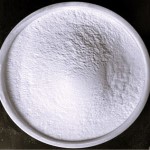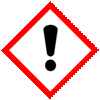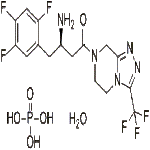CAS Number 654671-77-9 Monohydrate 654671-78-0 Anhydrous, Sitagliptin Phosphate Monohydrate USP BP Ph Eur IP EP Grade Manufacturers Exporters







CAS Number 654671-77-9 Monohydrate 654671-78-0 Anhydrous, Sitagliptin Phosphate Monohydrate USP BP Ph Eur IP EP Manufacturer Exporter
For Properties Specifications of Sitagliptin Phosphate Monohydrate Click Properties, Specifications of Sitagliptin Phosphate Monohydrate Manufacturer.
For Uses of Sitagliptin Phosphate Monohydrate Click Uses of Sitagliptin Phosphate Monohydrate Manufacturer.
For For SDS MSDS Sheet of Sitagliptin Phosphate Monohydrate Click SDS Safety Data Sheet MSDS Sheet of Sitagliptin Phosphate Monohydrate Manufacturer.
The Properties and Specifications of Sitagliptin Phosphate Monohydrate:
Sitagliptin Phosphate Monohydrate BP Ph Eur Grade Specifications:
C16H18F6N5O5P,H2O --- 523.3 CASC654671-77-9
Action and use: Dipeptidylpeptidase-4 inhibitor; treatment of diabetes mellitus.
DEFINITION
(3R)-3-Amino-1-[3-(trifluoromethyl)-5,6-dihydro[1,2,4]triazolo[4,3-a]pyrazin-7(8H)-yl]-4-(2,4,5-trifluorophenyl)butan-1-one phosphate monohydrate.
Content: 98.0 per cent to 102.0 per cent (anhydrous substance).
CHARACTERS
Appearance: White or almost white powder.
Solubility: Soluble in water, very slightly soluble in anhydrous ethanol, practically insoluble in heptane.
It shows polymorphism.
IDENTIFICATION
A. Infrared absorption spectrophotometry.
B. Enantiomeric purity.
C. Dissolve 0.200 g in water and dilute to 5.0 mL with the same solvent. The solution gives reaction (a) of phosphates.
TESTS
Enantiomeric purity: To pass the test by Liquid chromatography.
Related substances: To pass the test by Liquid chromatography.
Water: 3.3 per cent to 3.7 per cent, determined on 0.300 g.
Sulfated ash: Maximum 0.2 per cent, determined on 1.0 g in a platinum crucible.
Sitagliptin Phosphate USP Grade Specifications:
C16H15F6N5O-H3PO4-H2O --- 523.32
C16H15F6N5O-H3PO4 --- 505.31
1,2,4-Triazolo[4,3-a]pyrazine, 7-[(3R)-3-amino-1-oxo-4-(2,4,5-trifluorophenyl)butyl]-5,6,7,8-tetrahydro-3-(trifluoromethyl)-, phosphate (1:1) monohydrate;
7-[(R)-3-Amino-4-(2,4,5-trifluorophenyl)butanoyl]-3-(trifluoromethyl)-5,6,7,8-tetrahydro-1,2,4-triazolo[4,3-a]pyrazine monophosphate monohydrate;
(3R)-3-Amino-1-[3-(trifluoromethyl)-5,6-dihydro[1,2,4]triazolo[4,3-a]pyrazin-7(8H)-yl-4-(2,4,5-trifluorophenyl)butan-1-on phosphate monohydrate CAS 654671-77-9
UNII: TS63EW8X6F
UNII: QFP0P1DV7Z
DEFINITION
Sitagliptin Phosphate contains NLT 98.0% and NMT 102.0% of sitagliptin phosphate (C16H15F6N5O-H3PO4), calculated on the anhydrous and solvent-free basis.
IDENTIFICATION
A. Infrared Absorption
B. Meets the requirements of the test for Enantiomeric Purity.
C. Identification Tests—General, Phosphate: A solution containing about 40 mg/mL in water meets the requirements of the silver nitrate precipitation tests for orthophosphates.
Organic Impurities: to pass the test by Chromatography.
Water Determination: 3.3% to 3.7%
We also supply Sitagliptin Phosphate IP EP Grade.
The Uses of Sitagliptin Phosphate Monohydrate:
Sitagliptin Phosphate is a medicine used to treat type 2 diabetes.
The MSDS-SDS Hazard Statement of Sitagliptin Phosphate Monohydrate:
Sitagliptin Phosphate Monohydrate SDS, Safety Data Sheet
MSDS Sheet, Material Safety Data Sheet 13-Nov-24
1. Product Identification
Product Name & Other Names: Sitagliptin Phosphate Monohydrate.
CAS No.: 682-492-2 Monohydrate 871-227-8 Anhydrous
EINECS EC Number: 690-730-1
Relevant uses and uses advised against (if any): Industrial Manufacturing.
Suppliers: As per letterhead.
2. Hazards Identification
GHS, Globally Harmonized System Classification in accordance with 29 CFR 1910
Classification according to Regulation (EC) No 1272/2008
Serious eye damage/eye irritation Category 2A, H319
Specific target organ toxicity, repeated exposure Category 2, H373
Labeling according to Regulation (EC) No 1272/2008
GHS Label Elements  Irritant |
GHS Label Elements |
Signal Words: Warning
Hazard statements:
H319: Causes serious eye irritation.
H373: Causes damage to organs through prolonged or repeated exposure.
Precautionary statements:
P260: Do not breathe dust/fume/gas/mist/vapors/spray.
P280: Wear protective gloves/protective clothing/eye protection/face protection.
P312: Call a POISON CENTER or doctor/physician if you feel unwell.
P302+P352: IF ON SKIN: Wash with plenty of soap and water.
P304+340: IF INHALED: Remove victim to fresh air and keep at rest in a position comfortable for breathing.
P305+P351+P338: IF IN EYES: Rinse cautiously with water for several minutes. Remove contact lenses, if present and easy to do. Continue rinsing.
P337+P313: If eye irritation persists: Get medical advice/ attention.
3. Composition/Information on Ingredients
Product Name & Other Names: Sitagliptin Phosphate Monohydrate.
CAS No.: 682-492-2 Monohydrate 871-227-8 Anhydrous
EINECS EC Number: 690-730-1
4. First Aid Measures
Always seek medical attention after first aid measures are provided.
Inhalation: If inhaled, remove to fresh air. If not breathing, give artificial respiration. If breathing is difficult, give oxygen and get medical attention immediately.
Ingestion: Never give anything by mouth to an unconscious person. Get medical attention.
Skin Contact: Immediately flush skin with plenty of water for at least 15 minutes while removing contaminated clothing and shoes. Get medical attention. Wash clothing and shoes before reuse.
Eye Contact: Immediately flush eyes with plenty of water for at least 15 minutes, lifting lower and upper eyelids occasionally. Get medical attention immediately.
5. Fire Fighting Measures
Fire: Not a fire hazard. However, it can burn at high temperatures.
Fire Extinguishing Media: Water spray, dry chemical, alcohol foam, or carbon dioxide. Avoid solid water jet as it can spread fire.
Hazardous decomposition products formed under fire conditions: Oxide of nitrogen, oxides of carbon, fluorine compounds, phosphorous compounds, and fumes are expected to form.
Special Information: In the event of a fire, wear full protective clothing and NIOSH-approved self-contained breathing apparatus with full face piece operated in the pressure demand or other positive pressure mode.
6. Accidental Release Measures
Personal precautions, protective equipment, and emergency procedures: Avoid breathing dust/fumes/gas/mist/vapors/spray. Use individual protective equipment (waterproof boots, suitable protective clothing, safety glasses, etc.).
Environmental precautions: Do not let the product enter drains, soil, or water sources.
Methods and materials used for containment cleanup procedures and Storage: Do not inhale dust, vapors, mist, or gas. Avoid dust formation. Contain spilled material. Cover with an inert, non-combustible absorbent material, (e.g., sand, earth, diatomaceous earth, vermiculite). Use a shovel to put the material into a convenient waste disposal container.
7. Handling and Storage
Precautions for safe handling: Apply according to good manufacturing and industrial hygiene practices. Ensure proper ventilation. In case of insufficient ventilation, wear suitable respiratory equipment. Wash thoroughly after handling. Do not drink, eat, or smoke while handling. Avoid contact with skin, eyes, and clothing. Minimize dust generation. Avoid breathing dust/fumes/gas/mist/vapors/spray. Keep container tightly closed. Avoid ingestion and inhalation. Use individual protective equipment (waterproof boots, suitable protective clothing, safety glasses, etc.).
Conditions for safe storage, including any incompatibilities: Store in cool, dry, and ventilated area away from heat sources and protected from sunlight in tightly closed original container. Keep air contact to a minimum. Store protected from heat, sparks and ignition sources and incompatible materials.Avoid inhalation of dust/mist/vapor. Do not store with incompatible materials like strong oxidizing agents. Storage: Refrigerate.
8. Exposure Controls/Personal Protection
Airborne Exposure Limits: This product, as supplied, does not contain any hazardous materials with occupational exposure limits established by the region-specific regulatory bodies.
Ventilation System: A system of local and/or general exhaust is recommended to keep employee exposures as low as possible.
Personal Respirators (NIOSH Approved): For conditions of use where exposure to dust or mist is apparent and engineering controls are not feasible, a particulate respirator (NIOSH type N95 or better filters) may be worn.
Skin Protection: Wear impervious protective clothing, including boots, gloves, lab coat, apron, or coveralls, as appropriate, to prevent skin contact.
Eye Protection: Use chemical safety goggles and/or full-face shield where dusting or splashing of solutions is possible. Maintain eye wash fountain and quick-drench facilities in work area.
Other Control Measures: Maintain good housekeeping in work area. Handle in accordance with good industrial hygiene and safety practice. Wash hands after handling.
9. Physical and Chemical Properties
Appearance: White or almost white powder.
Odor: No data found.
Odor threshold: No data found.
pH: No data found.
Relative density: No data found.
Melting point/freezing point: No data found.
Initial boiling point and boiling range: No data found.
Flash point: No data found.
Auto-ignition temperature: No data found.
Decomposition temperature: No data found.
Upper/lower flammability or explosive limits: No data found.
Vapor pressure: No data found.
Vapor density: No data found.
Evaporation rate: No data found.
Flammability (solid, gas): No data found.
Partition coefficient: n-octanol/water: No data found.
Solubility: Soluble in DMSO and in water.
Viscosity: No data found.
10. Stability and Reactivity
Stability: Stable under ordinary conditions of use and storage.
Hazardous Decomposition Products: Oxide of nitrogen, oxides of carbon, fluorine compounds, phosphorous compounds, and fumes are expected to form.
Hazardous Polymerization: Will not occur.
Incompatibilities: Strong oxidizing agents.
Conditions to Avoid: Avoid incompatibilities, heat, flames, sparks, and other sources of ignition.
11. Toxicological Information
LD50 oral rat: No data found.
Carcinogenicity: No component of this product present at levels greater than or equal to 0.1% is identified as probable, possible, or confirmed human carcinogen by IARC.
Teratogenicity: No data found.
Reproductive toxicity: No data found.
Causes damage to organs through prolonged or repeated exposure.
12. Ecological Information
Toxicity to fish: No data found.
Persistence and Degradability: No No data found.
Mobility: No data found.
Bioaccumulation/ Accumulation: No data found.
Results of PBT and vPvB assessment: No data found for assessment.
13. Disposal Considerations
Whatever cannot be saved for recovery or recycling should be managed in an appropriate and approved waste disposal facility. Gollow all the pollution control norms.
14. Transport Information
DOT USA, TDG Canada & ADR/RID Europe: Not dangerous goods.
IMDG/IMO: Not dangerous goods.
IATA: Not dangerous goods.
15. Regulatory Information
No additional information is available.
Section 16 - Additional Information
Disclaimer:
**************************
Our company provides this MSDS sheet in good faith but makes no representation as to its comprehensiveness or accuracy. This SDS sheet is intended only as a guide to the appropriate precautionary handling of the material by a properly trained person using this product. The above information has been compiled from various sources and has the possibility of discrepancy and being out-dated information. Individuals receiving the information must exercise their independent judgment and do further search in determining its appropriateness for a particular purpose. In no case shall our company be liable to loss or damages by the product user.
**************************
Anmol Chemicals & Pharmaceuticals Pvt. Ltd. is an off-shoot of Anmol Chemicals Taloja. It is located in MIDC Taloja and it is manufacturing pharmaceutical grades of API, Excepients, Food grade and Reagent grade chemicals. Anmol Chemicals & Pharmaceuticals Pvt. Ltd. is a several decades old group of companies, engaged in manufacturing, supplying, distributing, wholesale supplies for actual users, retail or small pack supplies for research and development chemicals, fine and speciality chemicals, pharmaceutical excipients, mineral fortifiers in chemically pure, Analytical reagent grade, IP BP USP Ph Eur EP JP and other pharmaceutical grade monograph including FCC Food grade chemicals and Nutraceuticals, Mineral Fortifiers at best prices.

Sitagliptin Phosphate Monohydrate Structure
CAS Number 654671-77-9 Monohydrate 654671-78-0 Anhydrous, Sitagliptin Phosphate Monohydrate Manufacturer Exporter
ANMOL CHEMICALS & PHARMACEUTICALS Pvt. Ltd.
India, USA, Europe, UAE
TELEPHONE: +912223770100
Navi Mumbai, INDIA
e-mail: info(At the rate i.e. @)anmol.org
Copyright. 24-nov-24
We manufacture:


